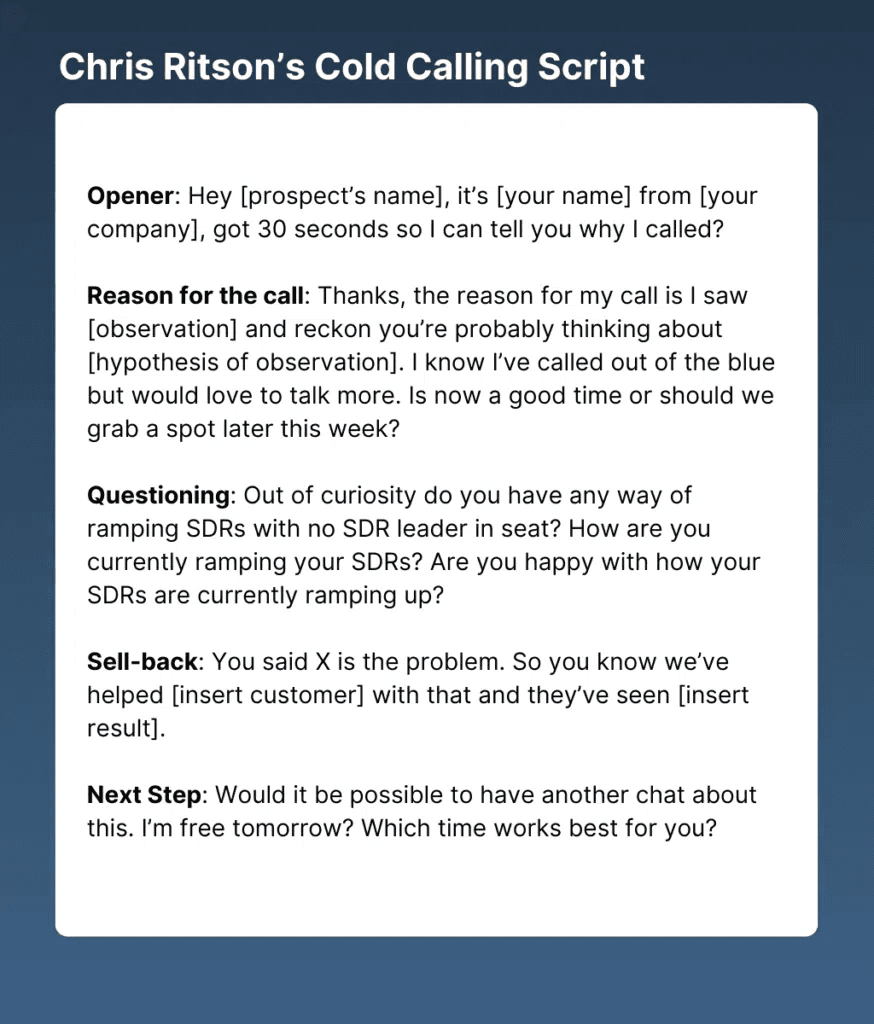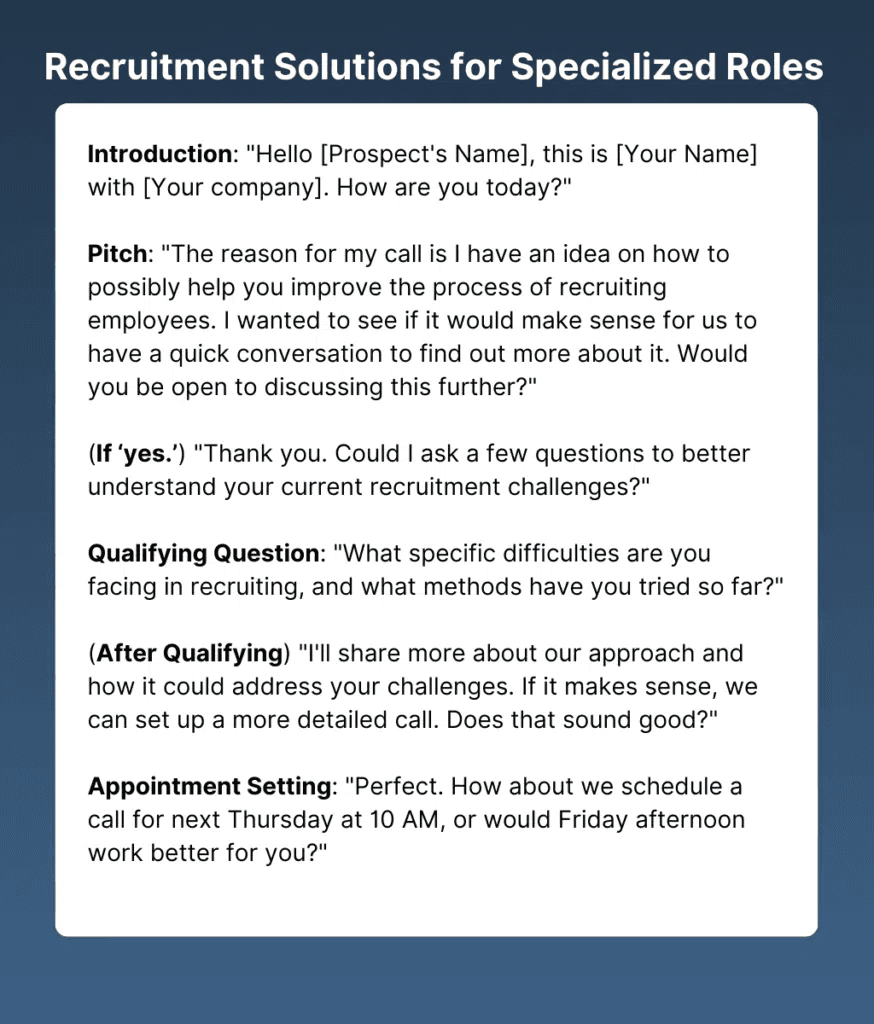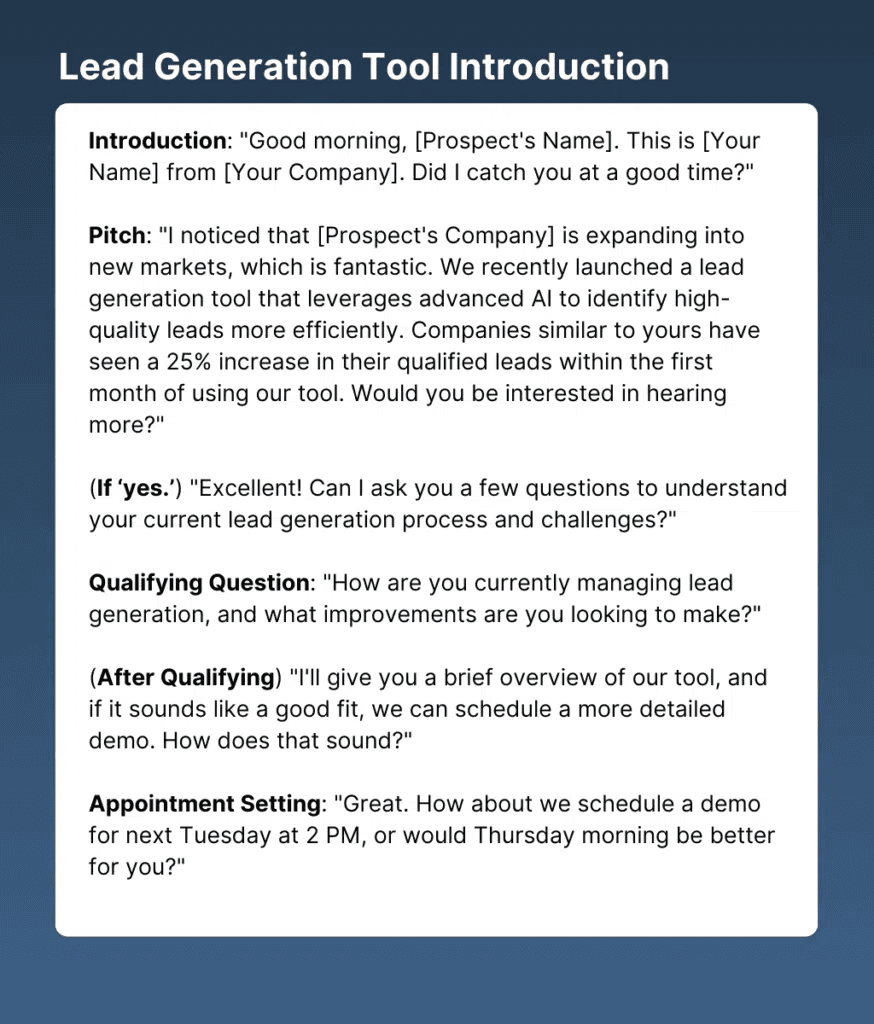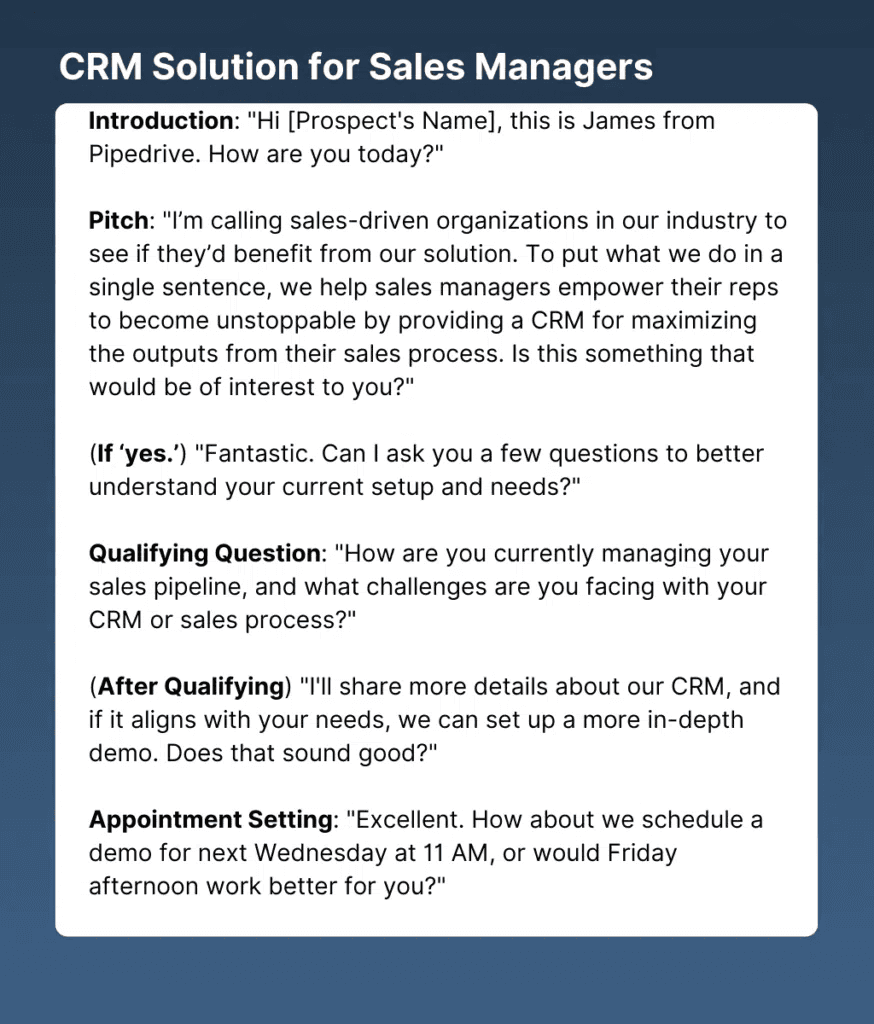
Aleksi
Mastering B2B cold calling can be one of the most challenging aspects of sales, but it’s also one of the most effective when done right.
In 2025, mastering B2B cold calling is more crucial than ever for increasing sales and growing your business.
Whether you’re a seasoned sales professional or new to the game, these 30 cold-calling tips will help you refine your technique, improve your sales prospecting, and boost your B2B sales.
We’ll cover everything from crafting the perfect opening line to handling objections with finesse. So, grab your phone and get ready to transform your cold-calling strategy with these actionable tips and techniques.
5 High-Performing Cold Calling Scripts
Chris Ritson’s Cold Call Script
Chris Ritson is a popular sales coach who helps businesses kickstart and train their SDR teams. He provided a cold calling script that offers a quick and direct-to-the-point approach when calling prospects.

Copy this template
Opener: Hey [prospect’s name], it’s [your name] from [your company], got 30 seconds so I can tell you why I called?
Reason for the call: Thanks, the reason for my call is I saw [observation] and reckon you’re probably thinking about [hypothesis of observation]. I know I’ve called out of the blue but would love to talk more. Is now a good time or should we grab a spot later this week?
Questioning: Out of curiosity do you have any way of ramping SDRs with no SDR leader in seat? How are you currently ramping your SDRs? Are you happy with how your SDRs are currently ramping up?
Sell-back: You said X is the problem. So you know we’ve helped [insert customer] with that and they’ve seen [insert result].
Next Step: Would it be possible to have another chat about this. I’m free tomorrow? Which time works best for you?
Recruitment Solutions for Specialized Roles
This script is made for a specific pain point – the recruitment process. It begins with a direct approach, offering a potential solution to a common challenge.
The primary objective is to initiate a conversation to explore the prospect’s needs to schedule a follow-up call for a deeper dive.

Copy this template
Introduction: “Hello [Prospect’s Name], this is [Your Name] with [Your company]. How are you today?”
Pitch: “The reason for my call is I have an idea on how to possibly help you improve the process of recruiting employees. I wanted to see if it would make sense for us to have a quick conversation to find out more about it. Would you be open to discussing this further?”
(If ‘yes.’) “Thank you. Could I ask a few questions to better understand your current recruitment challenges?”
Qualifying Question: “What specific difficulties are you facing in recruiting, and what methods have you tried so far?”
(After Qualifying) “I’ll share more about our approach and how it could address your challenges. If it makes sense, we can set up a more detailed call. Does that sound good?”
Appointment Setting: “Perfect. How about we schedule a call for next Thursday at 10 AM, or would Friday afternoon work better for you?”
Lead Generation Tool Introduction
This referral-focused script aims to expand your network within the industry by leveraging existing customer satisfaction.
Asking the prospect for referrals in a friendly and engaging manner. It opens the door for new opportunities while also offering incentives. The script seeks new leads but also reinforces the value your solution provides to current users.

Copy this template
Introduction: “Good morning, [Prospect’s Name]. This is [Your Name] from [Your Company]. Did I catch you at a good time?”
Pitch: “I noticed that [Prospect’s Company] is expanding into new markets, which is fantastic. We recently launched a lead generation tool that leverages advanced AI to identify high-quality leads more efficiently. Companies similar to yours have seen a 25% increase in their qualified leads within the first month of using our tool. Would you be interested in hearing more?”
(If ‘yes.’) “Excellent! Can I ask you a few questions to understand your current lead generation process and challenges?”
Qualifying Question: “How are you currently managing lead generation, and what improvements are you looking to make?”
(After Qualifying) “I’ll give you a brief overview of our tool, and if it sounds like a good fit, we can schedule a more detailed demo. How does that sound?”
Appointment Setting: “Great. How about we schedule a demo for next Tuesday at 2 PM, or would Thursday morning be better for you?”
CRM Solution for Sales Managers
The script focuses on navigating various interactions through personalization. It establishes a polite and professional tone.

Copy this template
Introduction: “Hi [Prospect’s Name], this is James from Pipedrive. How are you today?”
Pitch: “I’m calling sales-driven organizations in our industry to see if they’d benefit from our solution. To put what we do in a single sentence, we help sales managers empower their reps to become unstoppable by providing a CRM for maximizing the outputs from their sales process. Is this something that would be of interest to you?”
(If ‘yes.’) “Fantastic. Can I ask you a few questions to better understand your current setup and needs?”
Qualifying Question: “How are you currently managing your sales pipeline, and what challenges are you facing with your CRM or sales process?”
(After Qualifying) “I’ll share more details about our CRM, and if it aligns with your needs, we can set up a more in-depth demo. Does that sound good?”
Appointment Setting: “Excellent. How about we schedule a demo for next Wednesday at 11 AM, or would Friday afternoon work better for you?”
Marketing Automation Solution
This script leverages personalization and social proof to engage the prospect. Referencing successful results achieved for a similar client builds credibility and piques the prospect’s interest.
The goal is to demonstrate potential benefits and secure an appointment for a detailed discussion on how your solutions can replicate those successes.
Copy this template
Introduction: “Hi [Prospect’s Name], this is [Your Name] from [Your Company]. How are you today?”
Pitch: “Me and my company are seeing great results with [Client Company]’s marketing automation at the moment, and when talking about who else would benefit, your name came up. Congratulations on [recent achievement]. What you’re doing at [Prospect Company] is impressive! I’d love to show you how we’ve helped [Client Company] generate [Result] and how we may be able to do the same for you. Would this be of interest?”
(If ‘yes.’) “Great to hear! Could I ask you a few questions to tailor our discussion to your needs?”
Qualifying Questions: “What specific goals are you aiming to achieve with your marketing automation, and what obstacles are you encountering?”
(After Qualifying) “I’ll provide an overview of how we can assist, and then we can schedule a more detailed conversation if it makes sense. Does that work for you?”
Appointment Setting: “Wonderful. How about we schedule a follow-up call for next Monday at 3 PM, or would Wednesday morning suit you better?”
30 Tips for Cold Calling
1. Research Your Prospects Thoroughly
Before picking up the phone, invest time in researching your prospects. Understand their business, pain points, and recent news about the company.
Tailoring your pitch based on this information shows you value their time and increases the chances of a positive response.
2. Craft a Compelling Opening Statement
Your opening statement should grab the prospect’s attention immediately. Start with a personalized remark or an intriguing fact about their industry.
Show you’ve done your homework and are genuinely interested in their success. According to research, saying “How have you been?” had the highest rate of booking a meeting.
3. Use a Proven Script but Stay Flexible
Having a script helps maintain structure, but be ready to adapt based on the flow. A flexible approach lets you respond to the prospect’s needs and concerns. This makes the interaction more natural and engaging.
4. Focus on Building Relationships, Not Just Selling
Shift your mindset from closing a sale to building a relationship. Show genuine interest in your prospects and offer solutions tailored to their needs.
Establishing trust and rapport can lead to long-term business relationships and referrals. In the 5th Edition of Salesforce’s State of Sales, 80% of sales reps say maintaining customer relationships after the close is increasingly important.
5. Leverage Social Proof
Mention relevant case studies, testimonials, or success stories during your call. Demonstrating how your solution has helped similar companies can build credibility and reassure prospects of your product’s value.
6. Use Open-Ended Questions
Encourage dialogue by asking open-ended questions that require more than a yes or no answer. This approach helps uncover deeper insights into the prospect’s needs and challenges, enabling you to tailor your pitch more effectively.
7. Practice Active Listening
Active listening involves fully concentrating on what the prospect is saying. This helps you understand what they’re saying so you can respond thoughtfully.
Research has shown that active listening can increase collaboration and productivity by 25 percent. It also indicates respect and builds trust.
8. Be Persistent but Respectful
Follow up consistently but respectfully. You need to understand that prospects are busy and may not immediately reply. Regular follow-ups, spaced appropriately, keep you on their radar without being pushy.
Follow-ups are the lifeline of B2B sales because 48% of salespeople never even make a single follow-up attempt. By following up consistently, you’d be above most of the competition.
9. Time Your Calls Strategically
Identify the best times to reach your prospects. A study suggests that 4 PM to 5 PM is the best time to call your prospects. Setting ideal schedules for your cold calling can ensure that prospects answer your calls.
10. Develop a Strong Value Proposition
Clearly articulate the unique value your product or service offers. Focus on the specific benefits and solutions it provides to the prospect’s pain points. Also, emphasize why they should choose your offering over competitors.
11. Personalize Every Call
Tailor each call to the prospect. Refer to them by their name when you’re calling them. Personalization shows you’ve invested time in understanding their business.
12. Use Technology to Your Advantage
Utilize CRM systems, sales automation tools, and analytics to streamline your cold-calling process. These tools help track interactions, schedule follow-ups, and gain insights into prospect behavior, enhancing efficiency and effectiveness.
According to a McKinsey study, more than 30% of sales-related activities can be automated with today’s technology.
13. Keep Your Energy Up
Your tone and energy can significantly impact the prospect’s perception of you. Speak with enthusiasm and confidence. These qualities can be contagious and make the conversation more engaging and persuasive.
14. Handle Objections Gracefully
Prepare for common objections and develop strategies to address them calmly and confidently. Understanding the prospect’s concerns and providing reassuring responses can turn objections into opportunities.
15. Know When to Walk Away
Recognize when a prospect is not a good fit for your solution. Respect their decision and part ways amicably. This professionalism leaves a positive impression and opens the door for future opportunities or referrals.
16. Follow a Structured Call Framework
Implement a structured call framework to guide your conversation.
These include the following:
Introduction: Greet warmly and introduce yourself. You should establish rapport and state why you’re calling.
Discovery Questions: Ask open-ended questions. Actively listen and focus on uncovering pain points.
Value Proposition Presentation: Connect their pain points to your solution’s benefits. And focus on quantifiable benefits and ROI. Don’t forget to use customer testimonials or success stories to illustrate the impact of your solution.
Handling Objections: Be prepared to address common objections with clear, concise answers. Use the boomerang technique to rephrase their objection into a question to gain deeper insights and tailor your response.
Call to Action: Propose a clear next step. Make it easy for them to say yes and end the call with a thank you.
17. Use Silence to Your Advantage
Don’t be afraid of pauses during the conversation. Strategic silence can prompt the prospect to share more information. Which gives you valuable insights and demonstrates that you’re actively listening and considering their responses.
18. Practice Empathy
Put yourself in the prospect’s shoes. Understand their challenges, frustrations, and goals. Showing empathy creates a connection and demonstrates that you’re genuinely interested in helping them succeed.
19. Set Clear Objectives for Each Call
Define specific goals for each call, whether it’s securing a meeting, sending additional information, or advancing to the next stage in the sales process. Having clear objectives keeps the conversation focused and productive.
20. Use a Multi-Channel Approach
Combine cold calling with other outreach methods like emails, LinkedIn messages, and social media interactions. This approach, according to HBR, is as effective as or more effective than the previous sales model.
A multi-channel approach increases your chances of connecting with prospects and reinforces your message across different platforms.
21. Develop a Strong Elevator Pitch
Craft a concise and compelling elevator pitch that conveys your value proposition. Practice delivering it smoothly so you can confidently introduce your solution within the first few seconds of the call.
22. Invest in Continuous Learning
Stay updated with the latest sales techniques, industry trends, and market insights. According to data, companies spend an average of $2,020 per sales rep on training.
Continuous learning enhances your skills, keeps your approach fresh, and positions you as a knowledgeable resource for your prospects.
23. Track and Analyze Your Performance
Regularly review your cold-calling metrics, such as call volume, conversion rates, and response times. Analyzing your performance helps identify areas for improvement and refine your strategy for better results.
24. Leverage Gatekeepers
Gatekeepers, such as assistants or receptionists, can be valuable allies. Build rapport with them and seek their assistance in connecting with the decision-maker.
Respectful and professional interactions with gatekeepers can facilitate access to key contacts.
25. Incorporate Storytelling
Use storytelling to make your pitch more relatable and memorable. Share anecdotes or case studies that illustrate how your solution has positively impacted other clients. This makes your message more engaging and persuasive.
26. Be Mindful of Your Body Language
Even though cold calls are typically audio-only, your body language still affects your tone and delivery. Stand up, smile, and use gestures as if you were in a face-to-face meeting. This positive body language translates into a more dynamic and confident conversation.
27. Personalize Your Voicemails
When leaving voicemails, make them personalized and engaging. Briefly introduce yourself, mention a relevant detail about the prospect’s business, and provide a compelling reason for them to call you back. Avoid generic, scripted messages.
28. Create a Sense of Urgency
Encourage prospects to take immediate action by highlighting limited-time offers, upcoming deadlines, or the immediate benefits of your solution. Creating a sense of urgency can motivate prospects to prioritize your call.
29. Use the Power of Referrals
If possible, mention mutual connections or referrals during your call. Referrals provide instant credibility and can significantly increase the prospect’s willingness to engage with you.
Furthermore, in B2B sales, referrals can funnel up to 65% of a company’s new sales.
30. Maintain a Positive Attitude
Cold calling can be challenging, with frequent rejections. Maintain a positive attitude and resilience.
Celebrate small victories, learn from each interaction, and keep a long-term perspective to stay motivated and successful.


